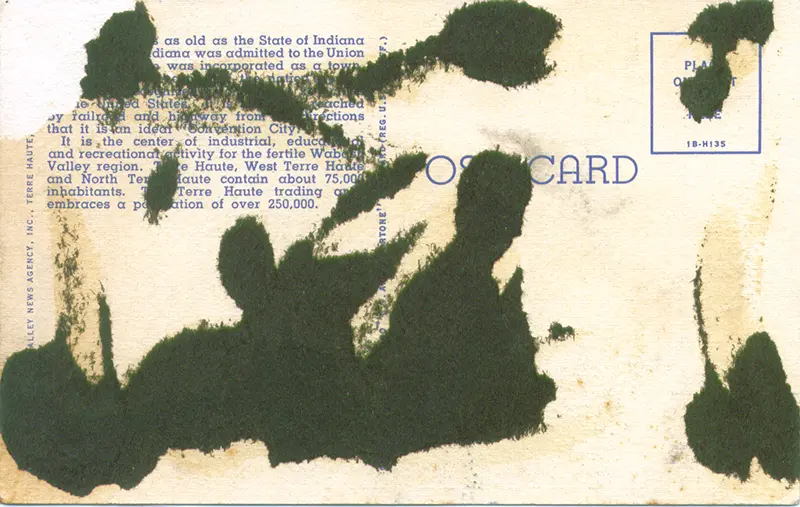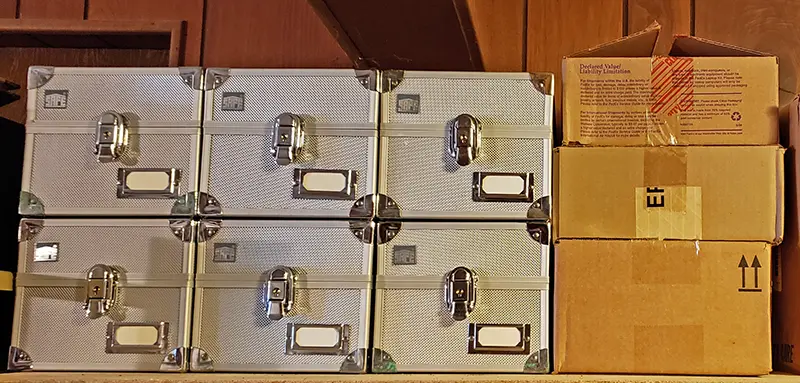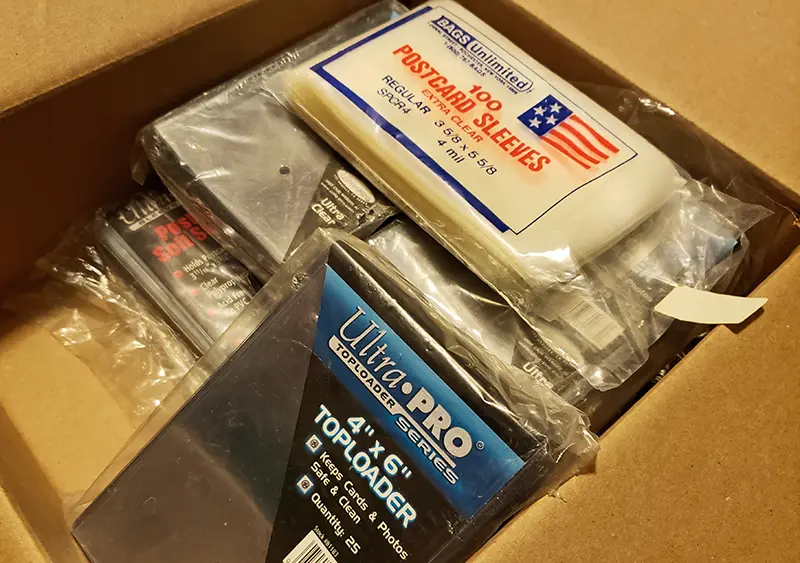Introduction
No matter what condition a card is in, once it is in your possession you should do your best to look after it and stop it deteriorating. There are several companies that specialize in protectors for paper products such as Bags Unlimited, BCW, Collector Safe, and Ultra-Pro. Whatever type of protection you use they should be archival quality and acid free. Some brands also pass the PAT (Photographic Activity Test).
Soft Sleeves
Most of these inexpensive sleeves are made from 2 mil polyethylene, polypropylene or polyester (Mylar). Of these, Mylar is used for professional archival purposes but is more expensive than polyethylene or polypropylene. Flexible (plasticized) PVC (Poly Vinyl Chloride) sleeves should not be used as the plasticizer can leach and the chloride can decompose causing damage to whatever is in the sleeve.
The most common material for these sleeves is polypropylene, but you can also find 2 mil and 4 mil soft sleeves made from polyethylene. I was a bit disappointed when I ordered a pack of each of these as these sleeves, despite being labeled "Extra Clear" are nowhere near as transparent as those made from polypropylene. Surprisingly however, when a postcard is placed inside them there really is hardly any difference between the polypropylene and polyethylene sleeves.
The problem with soft sleeves is that while they protect against scuffing and most damage caused by handling they cannot protect against bending and creases. The 4 mil sleeves are obviously thicker than the 2 mil sleeves but they will not prevent the postcard from creasing if they are bent.
Rigid Sleeves
These are also called toploaders (the opening is on one short side) or sideloaders (the opening is on one long side). Nearly all the rigid sleeves I've seen are made from 16 mil rigid (unplasticized) PVC, and are produced by the same companies that produce the soft sleeves.
One thing I find disconcerting is that while there is plenty of information regarding how harmful the plasticizers are in PVC, I cannot find any information on how safe these rigid PVC sleeves are for long term storage of postcards or other paper products. I think the manufacturer's also have the same problem. for example, BCW's 2 mil polypropylene soft sleeves have "No PVC" printed on the packaging as if all PVC might be harmful. Ultra-Pro has "Archival Safe" printed on the packaging of their 2 mil polypropylene soft sleeves, these words are missing from their 16 mil uPVC sleeves. However, it is possible to place the postcards inside soft sleeves and then place them inside the rigid sleeves.
Boxes
There are plenty of providers of storage boxes for postcards. The best kind are advertised as being "alkaline buffered and lignin free". Lignin is a natural product found in wood fibre and can make paper products darken when exposed to light. Many people use shoe boxes, but these should be safe so long as the individual postcards are kept in sleeves.
Albums
I like the idea of using albums to store and show off postcards. There are some problems with albums though. Many people pasted postcards into old albums, usually those made of heavy, black Kraft paper. Doing this ruins the back of the postcards. Not only that but the paper is not archive quality and the acid in it will eventually damage the postcards. The corners used for stamps can be used, but these need to be acid-free. The problem with paper album pages is that the backs cannot easily be seen and for many postcards the backs are nearly as interesting as the front.

A ruined postcard that had been pasted into a Kraft paper album
There are several types of plastic postcard albums around. Use the type where pages can be easily added or removed - this prevents lots of handling of the postcards as they are rearranged. Some people like to add two postcards to each slot in these pages. Again, these hide the back of the postcards so I prefer to use only one. Some postcards album pages are designed to fit standard 3-ring binders but this means that the four standard postcard (3 1/2 by 5 1/2 inches) size sheets are placed at right-angles to the spine. Pages for the continental and modern size postcards (4 inches by 6 inches) only hold three cards - two vertically and one horizontally. I prefer the larger album pages where each can hold 4 of postcards horizontally.
Be careful when choosing pages for the album as some slots are a very snug fit and the corners of the postcards can be damaged by taking them in or out of the individual pages.
My Storage
My wife bought these aluminium boxes for me as a gift. These things are great but fairly expensive at over $70 in the US, or £40 in the UK. The postcards are kept in sleeves inside the boxes.

Safe brand aluminium postcard boxes and cardboard boxes

A selection of hard and soft postcard sleeves
Sources & Resources
Bags Unlimited - Postcard supplies
BCW - Postcard supplies
First Aid for Postcards (Internet Archive)
Paper – What it’s up against article in History Matters, Volume 16 Number 1: February 2006 (Internet Archive)
Postcard Collecting Tips
Postcards: Navigating the Preservation Options (Internet Archive)
Preserving Treasures (Internet Archive)
Safe Collecting Supplies UK
Safe Collecting Supplies USA